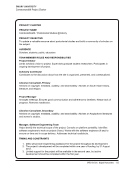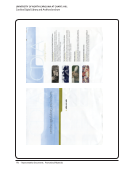SPEC Kit 326: Digital Humanities · 13
academic departments, library IT, or special one-time
funds, and about a third receive funding from en-
dowments. About three-fourths of the respondents
reported that researchers do not usually bring fund-
ing with them. In some case because they are still in
the grant writing stage of their project.
While formal policies governing library support
for DH projects are currently rare (only six libraries
reported having a written document), libraries are
developing mechanisms for managing these projects.
Sixteen respondents described proposal processes
that help determine whether a project warrants sup-
port based on academic criteria, such as research
significance and audience, as well as more practical
concerns such as resource availability and existing
workload. Proposals tend to be reviewed and ap-
proved by library management or, in some cases, a
library committee.
Policies and Procedures
Even when formal policies and proposal processes
are absent, about half of those who responded to the
survey use a Memorandum of Understanding, or
MOU, to define the roles and responsibilities of those
working on the project. Specifically, MOUs often de-
fine the scope of work, deliverables, timeline, costs
(and who pays them), deposit agreement (when items
will be placed in the library collection), downtime,
and hours of operation.
Sustainability
The majority of respondents (27 or 59%) indicated
that their libraries preserve digital humanities proj-
ects produced in-house. However, comments sug-
gested that many libraries’ preservation strategies are
selective or evolving: in a number of cases, preserva-
tion workflows are “in-process” or “under discus-
sion.” Those libraries that preserve digital humanities
projects adopt a range of sustainability strategies.
Most commonly, libraries create projects that adhere
to widely accepted standards for metadata. They also
commonly preserve digital projects in repositories
and create projects using widely supported platforms.
A number of libraries (18 or 51%) develop grant pro-
posals to ensure sustainability, while some work with
project planners to incorporate sustainability costs
into project cost estimates (37%) or audit projects for
long-term sustainability (31%).
Partnerships
Partnerships, both intra-institutional and inter-
institutional, are very common in the digital humani-
ties. Three-fourths of the responding libraries have
partnered with other units in their institutions, fre-
quently with university-wide technology services.
University departments and various centers and of-
fices were also common partners. Partnerships with
other institutions were less common (56%), though
respondents demonstrated a level of diversity within
those partnerships. Other universities were the most
common partners but non-profits and community
groups were well represented.
Assessment
Most of the responding libraries do not perform a
formal assessment of the effectiveness of their digital
humanities services. Of those that do, the primary
measures were level of demand and web analytics. A
slight majority of those that did assessments made or
plan to make adjustments as a result of them—some
technical, some logistical, and some programmatic.
Emerging Practices and Procedures
As mentioned above, library-based support for the
digital humanities is offered predominantly on an ad
hoc basis. However, as demand for services support-
ing the digital humanities has grown, libraries have
begun to re-evaluate their provisional service and
staffing models. Many respondents expressed a desire
to implement practices, policies, and procedures that
would allow them to cope with increases in demand
for services. A number of these models exhibit char-
acteristics that are noteworthy either for their unique-
ness or success. This section will examine noteworthy
emerging practices and procedures.
Library-hosted Digital Humanities Centers
Although not prevalent, a number of research libraries
are hosting dedicated digital humanities centers. At
this point it is difficult to say whether dedicated digital
humanities centers will become more common than
the more generalized digital scholarship centers as the
academic departments, library IT, or special one-time
funds, and about a third receive funding from en-
dowments. About three-fourths of the respondents
reported that researchers do not usually bring fund-
ing with them. In some case because they are still in
the grant writing stage of their project.
While formal policies governing library support
for DH projects are currently rare (only six libraries
reported having a written document), libraries are
developing mechanisms for managing these projects.
Sixteen respondents described proposal processes
that help determine whether a project warrants sup-
port based on academic criteria, such as research
significance and audience, as well as more practical
concerns such as resource availability and existing
workload. Proposals tend to be reviewed and ap-
proved by library management or, in some cases, a
library committee.
Policies and Procedures
Even when formal policies and proposal processes
are absent, about half of those who responded to the
survey use a Memorandum of Understanding, or
MOU, to define the roles and responsibilities of those
working on the project. Specifically, MOUs often de-
fine the scope of work, deliverables, timeline, costs
(and who pays them), deposit agreement (when items
will be placed in the library collection), downtime,
and hours of operation.
Sustainability
The majority of respondents (27 or 59%) indicated
that their libraries preserve digital humanities proj-
ects produced in-house. However, comments sug-
gested that many libraries’ preservation strategies are
selective or evolving: in a number of cases, preserva-
tion workflows are “in-process” or “under discus-
sion.” Those libraries that preserve digital humanities
projects adopt a range of sustainability strategies.
Most commonly, libraries create projects that adhere
to widely accepted standards for metadata. They also
commonly preserve digital projects in repositories
and create projects using widely supported platforms.
A number of libraries (18 or 51%) develop grant pro-
posals to ensure sustainability, while some work with
project planners to incorporate sustainability costs
into project cost estimates (37%) or audit projects for
long-term sustainability (31%).
Partnerships
Partnerships, both intra-institutional and inter-
institutional, are very common in the digital humani-
ties. Three-fourths of the responding libraries have
partnered with other units in their institutions, fre-
quently with university-wide technology services.
University departments and various centers and of-
fices were also common partners. Partnerships with
other institutions were less common (56%), though
respondents demonstrated a level of diversity within
those partnerships. Other universities were the most
common partners but non-profits and community
groups were well represented.
Assessment
Most of the responding libraries do not perform a
formal assessment of the effectiveness of their digital
humanities services. Of those that do, the primary
measures were level of demand and web analytics. A
slight majority of those that did assessments made or
plan to make adjustments as a result of them—some
technical, some logistical, and some programmatic.
Emerging Practices and Procedures
As mentioned above, library-based support for the
digital humanities is offered predominantly on an ad
hoc basis. However, as demand for services support-
ing the digital humanities has grown, libraries have
begun to re-evaluate their provisional service and
staffing models. Many respondents expressed a desire
to implement practices, policies, and procedures that
would allow them to cope with increases in demand
for services. A number of these models exhibit char-
acteristics that are noteworthy either for their unique-
ness or success. This section will examine noteworthy
emerging practices and procedures.
Library-hosted Digital Humanities Centers
Although not prevalent, a number of research libraries
are hosting dedicated digital humanities centers. At
this point it is difficult to say whether dedicated digital
humanities centers will become more common than
the more generalized digital scholarship centers as the
































































































































































































